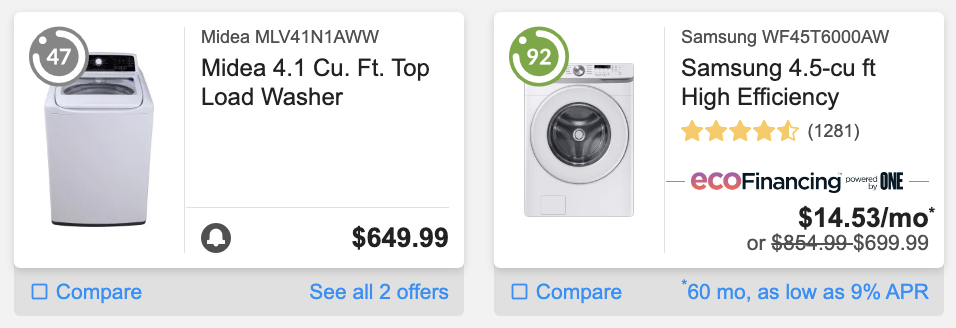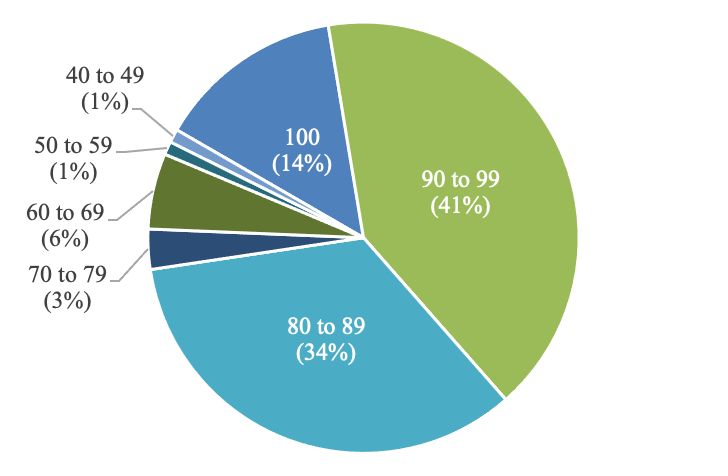Product efficiency has steadily improved thanks to innovation, federal standards, the ENERGY STAR label, and shifting consumer preferences. Below, we share Enervee data showing how the Enervee Score® and industry partnerships accelerate innovation cycles—and how pairing guidance with inclusive checkout on a utility marketplace can move shoppers to buy the most efficient models.
Why it matters
By updating standards across 47 products, the U.S. Department of Energy could cut peak demand by another ~90 GW by 2050—about 13% of today’s peak load [1]. Yet even with standards, the market still offers a wide efficiency range within each category. The question is: how do we shift demand toward the most efficient choices?
How the Enervee Score guides better choices
The Enervee Score is a 0–100 relative energy-efficiency index that gives shoppers a fast, visual signal [2]. For clothes dryers, models scoring above 90 tend to be heat-pump designs that reuse heat and avoid exterior ducting. While heat-pump dryers can list as high as ~$1,900, current models start near ~$800—competitive with similarly sized conventional electric units.

The conventional dryer on the left uses ~260 kWh/year at a similar price to the heat-pump model on the right, which uses ~145 kWh/year (~44% less). Over a 16-year lifetime, that’s roughly 1,840 kWh saved—about $250 at the U.S. average of $0.14/kWh (and up to ~$680 at Hawaii rates).
From signal to action: how higher-efficiency purchases happen
The score doesn’t just reveal efficiency—it changes outcomes. Two mechanisms matter:
- Retail/manufacturer alignment. The score enables partners to spotlight efficient models with targeted discounts. In the example below, a high-scoring Samsung washer is discounted to parity with less-efficient top-loaders.

- Inclusive monthly payments. For many households, lump-sum prices are the barrier. At checkout, Eco Financing converts a $500–$1,000+ appliance into affordable fixed monthly payments [3]. In the washer example, payments can land under ~$15/month (representative), letting shoppers choose an efficient front-loader that uses ~22% less energy (and less water) than typical low-cost top-loaders.
What people actually buy
On Enervee marketplaces with integrated Eco Financing, dishwashers, clothes washers, and gas dryers purchased are highly efficient: 89% scored ≥ 80 (average 88, median 90), and 14% scored a perfect 100—even though products in the 60s were finance-eligible. For washers and dryers, financed purchases skew to higher scores than credit-card purchases.

Importantly, the majority of loans go to underserved customers (LMI tracts and/or limited credit)—evidence that pairing guidance with inclusive payments elevates efficiency outcomes for those traditionally left out.
Speeding innovation: dynamic benchmarks vs. static labels
Minimum efficiency standards retire the worst models. To move the frontier, programs often use “technology-forcing standards” (TFS): forward-looking benchmarks that stimulate next-gen products without prescribing a specific design [4].
The Enervee Score operates as a dynamic benchmark. Because it updates daily and spans the whole market, it keeps pressure on the top end—while also letting retailers and OEMs participate (e.g., targeted promos) and guiding consumers to the best options in real time.
ENERGY STAR plays a vital role, but it isn’t designed to always reflect the very top of market. In 2020, 100% of dishwashers, 55% of clothes washers, and 37% of electric dryers shipped with ENERGY STAR [5]. Within those pools, Enervee Scores still range widely (e.g., dishwashers ~62–97; washers ~66–100; electric dryers ~53–100), giving shoppers and market actors a clearer view of “best available” today.
Bottom line
Standards set the floor; dynamic guidance and inclusive payments raise the ceiling. Using the Enervee Score to highlight top performers—and embedding financing at checkout—drives more super-efficient purchases across diverse shoppers, accelerating market transformation when it matters most.
References
- A Powerful Priority: How Appliance Standards Can Help Meet U.S. Climate Goals and Save Consumers Money.
- Flip sides of the same coin? A simple efficiency score versus energy bill savings information….
- Predicting the human response to Eco Financing.
- Technology-Forcing Standards for Energy Efficiency (IEA 4E).
- ENERGY STAR® Unit Shipment & Market Penetration Report (2020).
